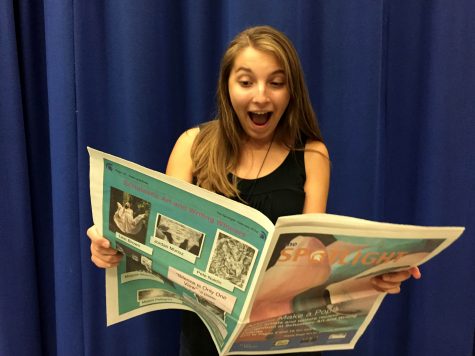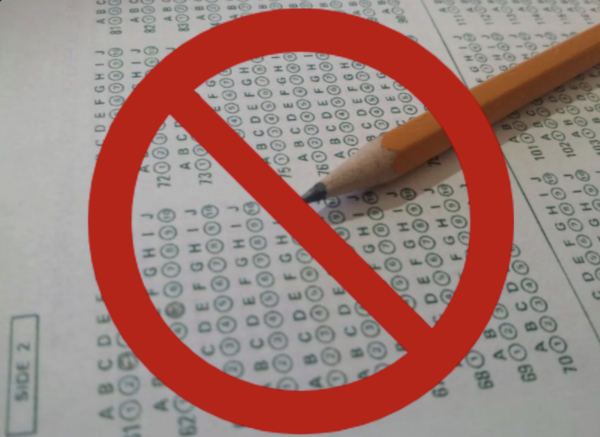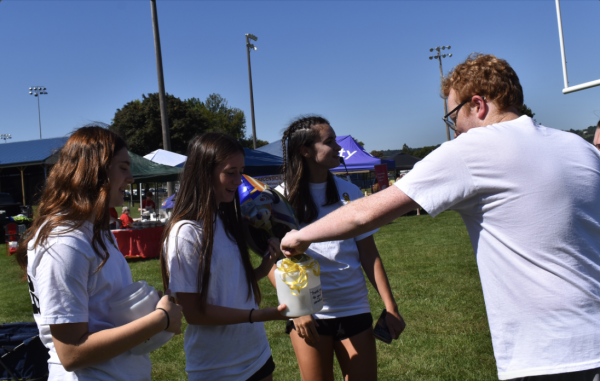Why Creativity in School Matters
To quote author and speaker on creativity, Sir Ken Robinson, “We don’t grow into creativity. We grow out of it. Or rather, we get educated out of it.”
It’s true. We spend preschool and kindergarten playing with blocks and making finger puppets, but as we grow older, our lives become more and more consumed with achieving that perfect SAT score or perfectly meeting the standards of a rubric.
“I think on the surface [schools] claim to encourage thinking differently, but when it comes down to it, by forcing us to do standardized tests and think in a certain way in order to get the grades we want they do discourage creativity, no matter how much they say they encourage it,” sophomore Melissa Stough said.
According to research conducted by Kyung Hee Kim, a professor of education at the College of William and Mary, student creativity has been on the decline for decades. After reviewing nearly 300,000 scores of K-12 children on the Torrance Tests of Creative Thinking, Kim revealed that, “that children have become less emotionally expressive, less energetic, less talkative and verbally expressive, less humorous, less imaginative, less unconventional, less lively and passionate, less perceptive, less apt to connect seemingly irrelevant things, less synthesizing, and less likely to see things from a different angle.”
Schools do not foster the amount of creativity that they need to, and that’s because of the way they’re being run. Standardized testing is a huge culprit on this creativity crisis because preparation steals valuable time that could be used for student innovation. Between the SATs, Keystones, and AP tests, many classes culminate in some sort of test. According to a report published by the American Federation of Teachers, about 15 percent of instructional time is devoted towards preparing for a test.
“I think testing has stifled creativity because I feel like there is a push to make sure that we move at a pace to address the standardized tests,” English teacher Mrs. Amy Bausher said. “So sometimes we may be moving faster through a unit and then something has to give and we may eliminate a project or an opportunity to look at a piece of literature in a more creative approach.”
In addition, excessive testing has forced students to adopt the outlook that there is only one correct answer. As Robinson puts it, “We’re now running national education systems where mistakes are the worst thing you can make.”
This emphasis on bubble sheet answers calls for students to approach a subject or problem in one specific way. For example, students aren’t able to make personal interpretations of subjective texts on SAT and Keystone reading exams because it isn’t the correct answer by the test’s interpretation of the text.
“Not that I don’t see values to tests, but that’s become such a focus that creativity is something that is gone to the wayside,” social studies teacher Mr. Matt Cooper said. “We’re more focused on knowing things and not knowing why we need to know them or why they’re important. To me education is not about knowing something for a test now. It’s about continuing to learn and be creative and understand why we’re learning things.”
“Standardized testing does stifle creativity because I don’t have much time to do creative things nowadays because it’s mostly focused on school work, which isn’t creative,” junior Amir Gold said. “I get a thrill out of doing projects like public speaking because I can be creative. I can use humor, I can ramble on, I can do research that I normally wouldn’t. But when it comes to SATs, they have to express the problems in text, and it’s hard to express things to which creativity can be applied in text.”
So what happens if we remain trapped in this box? Short-term, intense structuralized education is destructive for both teachers and students. In a one study conducted by Harvard University, they found that students in the bottom 10 percent of their class were 33 percent more likely to drop out of high school if they needed to pass standardized exams to graduate.
“I think students get frustrated and bored,” Mrs. Bausher said. “I think they get turned off to education or feel like they’re going through the same routine day in and day out, so I feel like they get tired and feel like their voices aren’t being heard.”
In addition, intense “teaching to the test” discourages teachers in their profession.
“The whole system is set up so that even the people in charge don’t have control over what they need to teach,” senior Ada Steward said. “Teachers can’t do anything because of what the course requires. Instead of learning what we’re interested in, we’re learning what the [department of] education wants us to, which is how to take standardized tests.”
This creativity crisis has long-term effects as well. Less creativity means less problem solving, less innovation, and less progress. It prevents people from being able to express themselves and discover what makes them tick, leading to poor job satisfaction.
“If you don’t have any creativity do you have any passion?” science teacher Mr. David Dougherty said. “So then you have a meaningless existence. When you go out there and go to your careers, there’s no summer vacation, no moving onto your next grade. You hit it and you stay there.”
I recognize the fact that SATs do have value. They measure student achievement and can be used to compare how schools are performing academically. However, this doesn’t mean that we can afford to let our creativity fall. Creativity is an invaluable skill, and we need to ensure that our curriculum includes room for students to express themselves, rather than box them in.
“A program that a student is in should also be assessing the creativity of a student,” math teacher Mr. Ryan Haupt said. “The arts and the electives are the main outlets for creativity, not that we don’t do that in core classes. For example, in English we write stories, and in math we go about solving problems differently. I think a curriculum program, if it’s done correctly, should address a student’s creativity and ability to grow creatively.”

Throughout her four years at Southern Lehigh High School, Talia Trackim has surely established herself as the girl who does it all. She joined the Spotlight...











